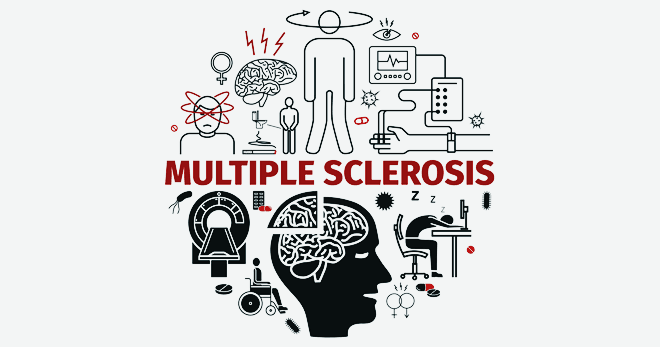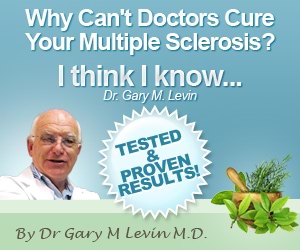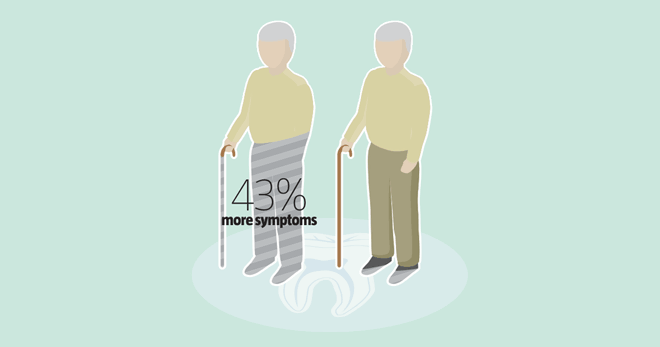Multiple sclerosis has long baffled conventional medicine, but a few pioneers have discovered a number of triggers that set off the MS disease, including vitamin D deficiency and a high-fat diet.
Elena Ravalli was 37 years old when she was diagnosed with MS in 1995, after she had complained of numbness, vertigo, temporary vision loss and fatigue – all of which are classic symptoms of the disease.
But what followed was anything but classic or conventional, and it has thrown open the debate on MS – what it is, what causes MS, and how it might be connected to a range of other neurodegenerative diseases such as Alzheimer’s, Parkinson’s and dementia.
Elena’s husband is Paolo Zamboni, a professor of vascular diseases at the University of Ferrara in northern Italy. Prompted by his wife’s diagnosis, he began to explore the disease and its common characteristics, and quickly became convinced that doctors didn’t have the whole story.
What Is Multiple Sclerosis?
MS, which afflicts around 2.5 million people worldwide, is believed to be a disease of the central nervous system (CNS) – which includes the brain and spinal cord – and, more specifically, it is described as an ‘inflammatory demyelinating’ condition.
Nerve-cell branches, or axons, in the CNS are protected by a fatty coating – called the ‘myelin sheath’ – which is eroded away (demyelinated) by inflammation, a process that results in scars or sclerosis (hardening similar to that seen in the arteries, or arteriosclerosis). Demyelination tends to occur in the white matter of the brain and spinal cord, although MS symptoms vary, depending on the severity of the damage and the axons affected.
Doctors don’t know exactly what causes the initial inflammation. However, there is some evidence that it could run in families, although this has not been scientifically established. The prevailing theory is that MS is caused by stress and infection.
Multiple Sclerosis Symptoms and Signs
MS symptoms include those that are sensory (resulting in problems with sensations) and related to motor control (muscle movements and coordination). The most common multiple sclerosis symptoms include:
- Vision changes including blurred or double vision. Some might experience partial blindness, dimmed vision, inability to see straight ahead (central vision loss) and uncoordinated movements of the eyes. Vision changes are due to increased inflammation of the optic nerves leading to the eyes (optic neuritis).
- Cognitive changes and mental impairment, including trouble thinking clearly, memory loss, poor judgement and inattention.
- Lack of coordination, clumsy movements and loss of balance.
- Numbness, tingling, reduced sense of touch.
- Sense of shock running down the neck and spinal cord, especially when moving the head/neck.
- Burning, itching or pain on the skin.
- Cramping, spasms and weakness in the arms or legs, tremors, trouble walking, and stiffness.
- Mood changes, including mood swings, depression or manic depression, inability to control emotions, increasing crying and inappropriate laughing.
- Sexual dysfunction, including lack of sensation in the genitals, trouble experiencing pleasure or orgasm, and impotence.
- Dizziness and vertigo.
- Digestive symptoms including constipation, diarrhea/loss of control over bowel movements, and trouble controlling urination.
- Slowed, slurred and hesitant speech.
- Partial paralysis and involuntary movements as the condition worsens.
- Dementia and mania as the condition worsens.
Iron in the Brain
Zamboni found something else. Most of the studies he researched revealed very high levels of iron in the brains of MS patients. But, more significantly, the veins that carry blood away from the brain were twisted and obstructed in up to 90% of MS patients.
These blockages caused blood to flow back into the brain, leaving behind iron deposits, which might possibly be a cause of the associated inflammation and autoimmune reactions.
So MS may fundamentally be a vascular disease, he argued – which led him to rename the condition ‘chronic cerebrospinal venous insufficiency’ (CCSVI). His wife became his first guinea pig, and she underwent pioneering surgery to unblock the veins near to her brain.
Astonishingly, her symptoms disappeared immediately – as, indeed, they have for hundreds of other MS patients who have undergone Zamboni’s surgical technique, which he calls ‘Liberation Treatment’.
By 2009, Zamboni had refined the operation and was using angioplasty – where a catheter-inserted balloon in a blocked vessel is expanded to ‘open it up’ – to unblock cerebral veins.
In one of his earlier ‘pilot’ studies involving 65 MS patients, half did not suffer a relapse – when symptoms reappear after a period of relief – whereas only 27% had been relapse-free before the operation.
The average relapse rate for the group overall, however, was not improved by the procedure, and most of the ‘unblocked’ veins became stenotic (restricted) again during the 18-month follow-up.(1)
The first independent preliminary research results have so far been even more ambiguous. In the large-scale, randomized, ongoing Combined Transcranial and Extracranial Venous Doppler Evaluation study, which began in April 2009, researchers at the State University of New York in Buffalo have been using Doppler ultrasound scans to look for signs of CCSVI in 499 adult study participants, 289 of whom had MS.
However, the researchers found that only around 56% of the MS patients fulfilled criteria for CCSVI, compared with around 42% of those with some other neurological disorder and 22% of the healthy controls.(2)
The plan is now to recruit a further 500 subjects for a phase-II clinical study and to assess them with more advanced diagnostic tools.
A Search in Vein?
Other research has been considerably more damning – finding no evidence of any causal link between CCSVI and MS. In a study headed by Florian Doepp, an expert in venous blood drainage at Humboldt University in Berlin, the brains of 56 patients with MS (and 20 controls) were examined by color-coded ultrasound and various blood-flow analysis, and no evidence whatsoever of CCSVI could be found.(3)
Another study from Germany, this one by researchers at Goethe-University Frankfurt, came to a similar conclusion. In a report ironically titled ‘The perfect crime? CCSVI not leaving a trace in MS’, the researchers again could find no evidence of venous obstruction or retrograde flow in the brains of 20 MS patients and 20 healthy controls using extracranial and transcranial color sonography.(4)
Likewise, researchers at University Hospital in Padova, Italy, could find no evidence of a cause-and-effect relationship between CCSVI and inflammatory lesions indicative of possible MS on examining 50 such patients along with a further 50 age and gender-matched healthy controls.(5)
Despite these negative results, there is still the elephant in the room that needs to be addressed: why have so many MS sufferers dramatically improved after undergoing Zamboni’s so-called Liberation Treatment?
Robert Zivadinov, who is heading up the research team at Buffalo, believes he has found the answer in the initial findings already assembled.
“CCSVI is not the cause of MS, but might be a consequence or a contributing factor to progression, and I think that has to be studied,” he says. “What Professor Zamboni discovered in terms of veins is something much bigger than MS. We need to understand the role of the venous system in the pathology of central nervous diseases and aging.”
The Alzheimer’s Connection
If constrictions and obstructions in the venous system are a characteristic of neurodegenerative diseases in general and not just MS, this suggests there might be a common feature shared by other autoimmune and/or inflammatory conditions such as Parkinson’s and Alzheimer’s, which are usually associated with aging.
Researcher Carmelina Gemma at the University of South Florida in Tampa has pointed out that inflammation and degeneration are both present at certain time points in many chronic neurological disorders. Alzheimer’s starts with degeneration and is followed by inflammation, whereas the opposite occurs in MS, she says.(6)
MS is also similar to stroke, Alzheimer’s and schizophrenia in that they are all conditions characterized by damage to nerve cell communication (synapses) in brain white matter.(7)
Indeed, post-mortem brain examinations of MS and Alzheimer’s victims, using histochemical techniques, have shown similar damage,(8) allowing breakthroughs in our understanding of inflammation and neurodegenerative diseases that are nothing less than a “paradigm shift” in neuropathology, say researchers at the Cecilie Vogt Clinic for Neurology in Berlin.(9)
Nevertheless, if MS is not an isolated disease entity, but a member of a subset of inflammatory conditions that includes Alzheimer’s, Parkinson’s, stroke and schizophrenia, then the $64,000 question remains: what’s causing them?
While everything from family history and viral infection to artificial sweeteners and power lines have been mooted as causes,(10) the most compelling evidence was amassed over 65 years ago – and systematically ignored ever since.
The Swank Hypothesis
There’s one further feature shared by neurodegenerative diseases, researchers at Duke University have discovered. In a study of 770 families with Parkinson’s patients, they found genetic modifications or changes in vitamin D receptors that rendered them unable to process vitamin D, the main source of which is sunlight.(11)
In addition, George Ebers and his colleagues at the University of Oxford Wellcome Trust Centre for Human Genetics found a close relationship between MS and exposure to sunlight when they assessed the prevalence of the disease in Scotland.
The rate of the disease rose significantly among populations in the more northerly latitudes, where sun exposure was minimal.(12)
The same team found a similar strong association when they explored rates of MS in various regions of France. Indeed, the prevalence of MS was sometimes almost twice as high in places with low levels of sunlight, as measured by ultraviolet B (UVB) radiation levels.(13)
Dr. Roy Swank, a neurologist at the Oregon Health & Sciences University in Portland, anticipated this discovery some 65 years ago.
Swank, who died in 2008 at the age of 99, was one of the first to identify a link between geographical location and the amount of sunshine we’re exposed to and poor diet and MS. And as the Duke University researchers were to discover much later, it wasn’t just about our exposure to vitamin D, but also our ability to process it.
In 1948, Western Europe was a ready-made laboratory for Swank’s research. It was just three years after a devastating war and diets had changed dramatically across the continent. His first studies took place in Norway, where he discovered that MS was rare in coastal regions and nine times more commonplace in the mountains.
Not surprisingly, those living along the coast had a diet rich in seafood, while people living in isolated mountain areas tended to eat more meat, milk, eggs and cheese.(14)
From this and other studies, Swank surmised that MS might be reversed by eating a low-fat diet, a theory that was proven in a group of 150 MS sufferers who agreed to follow such a dietary regime from 1949 and throughout the subsequent years – astonishingly, Swank stayed in touch with them right up until 2000.
They were contacted every three months and, once a year, Swank and his team would examine them.
Some of the MS patients were unable to stick to the low-fat diet; nevertheless, by 1991, 31% of those eating an average of only 17 g/day of fat had died compared with 79% of those eating around 25 g/day and 81% of those eating 41 g of fat every day.(15)
Swank also noted the phenomenon that Zamboni had based his CCSVI theory on: MS sufferers have poor blood flow in the brain and it progressively worsens. And Swank had taken Zamboni’s theory one step further by maintaining that the cause of the poor cerebral blood flow was the modern diet high in saturated fats.(16)
Modern Crimes
If Swank was right and MS is primarily caused by our modern high-fat diet, it follows that it’s a disease that should be increasing in prevalence – and the history of MS appears to bear this out.
One of the earliest recorded instances of the disease was in the mid-1800s, and it had become a well-recognized disease by the turn of the 20th century, just 50 years or so later. Even by 1922, New York neurologist Israel S. Wechsler had noted that MS incidences had increased over the previous 20 years.(17)
Swank himself noted a 50% increase from 1935 to 1958 in Montreal, Quebec, while a more recent study in the highly genetically stable population of Sardinia showed that the disease had increased around sixfold over the nearly 35 years prior to 1999.(18)
Researchers at the Wellcome Trust Centre for Human Genetics in Oxford together with the Canadian Collaborative Study Group uncovered further clues that pointed to MS being a lifestyle and environmental disease.
In a study of around 27,000 MS patients, they found that the prevalence of the disease in men and women had shifted dramatically over the previous 50 years – from affecting both genders almost equally to, by 2006, affecting 3.2 women for every man with the disease.(19)
The Missing Piece
MS is still a relatively rare disease. The overall risk of developing the disease is just one in 700 compared with, say, the one in three risk for cancer and the one in 22 risk for chronic heart disease.
If Swank is right and given the large numbers of people in the West who consume a high-fat diet, you might expect that more people should be suffering from MS (although the rate does rise dramatically when MS is viewed as a subset within the wider range of neurodegenerative diseases).
The late Charles Poser, a neurologist at Harvard Medical School, believed he had the missing piece of the puzzle. He was tantalized by MS rates in Hawaii, which varied wildly across the various ethnic groups living there.
Caucasians born in California, but now living in the Islands, had three times the rate of MS compared with Caucasians born and raised there. On the other hand, Hawaii-born Japanese had triple the rate of MS compared with those born and raised in Japan, but now living in Hawaii.(20)
Poser explained these contradictory data with his multiple sclerosis trait (MST) theory, which proposed that some people are genetically susceptible to MS – they have the MST – yet do not necessarily ever develop the disease.
Only when a certain environmental ‘event’ occurs will they manifest MS – and such an event could be anything from infection, vaccination, a high-fat diet or inadequate exposure to sunshine.(20)
This theory is supported by an Italian study that used magnetic resonance imaging (MRI) in 240 people were related to an MS sufferer either because it ran in the family (familial MS) or it suddenly appeared (sporadic MS). None of the participants had themselves been diagnosed with MS.
The researchers found that 10% of those with familial MS had brain lesions identical to those found in actual MS sufferers – but no symptoms – whereas 4% of those with no family history of MS also had similar lesions. This suggests that those with lesions were all carriers of the MST, but nothing in their life had so far triggered its manifestation.(21)
A Response, Not a Disease
So what exactly is MS? Poser and Swank established that it’s not an autoimmune disease, as doctors have maintained, but an autoimmune response.
Such a response – which may include poor blood circulation – is likely to be triggered by a viral infection like shingles or chickenpox, a high-fat diet, food intolerance, nutritional deficiency (vitamin D in particular) and/or parasites.
This means that MS is not a progressive and incurable disease, but a response that may be halted, once the cause has been identified and reversed. Poser also demonstrated that, on its own, simply having a genetic proclivity is not enough to trigger MS.
Doctors are not trained to ask the ‘why’ question and, yet, that’s the one patients most want answered: why do I have X? If medical professionals were so trained, they might be closer to reversing the so-called ‘autoimmune diseases’ such as MS, Alzheimer’s and Parkinson’s, instead of merely treating their symptoms.
The Amalgam Connection
Amalgam dental fillings could be a cause of multiple sclerosis, and they certainly contribute to worsening of MS symptoms. These fillings – which include mercury, the most toxic metal known to man – can affect MS patients’ mental health, making them more depressed, hostile, psychotic and obsessive-compulsive.
When researcher R.L. Siblerud at the Rocky Mountain Research Institute in Colorado assessed the mental health of 47 MS patients with amalgam fillings, and compared them with 50 patients whose fillings had been removed, those with amalgam fillings had 43% more symptoms compared with those free of such fillings.(1)
As a possible cause of MS, when researchers did a systematic search of the literature and pooled a range of relevant studies published between 1966 and 2006, they found a slight but consistent association between amalgam fillings and MS.(2)
References:
(1) Psychol Rep, 1992; 70:1139-51
(2) J Public Health Dent, 2007; 67: 64-6
Ideal Multiple Sclerosis Treatments
Since each drug will come with its own set of side effects, it’s important, as much as possible, to opt for a more holistic approach and address MS with the following methods:
Increasing Exercise: Working out may assist in boosting strength, balance, muscle tone and coordination. Exercises that are ideal for multiple sclerosis include walking, stretching, low-impact aerobics, yoga, tai chi, stationary bicycling or swimming and other water exercises (if dealing with heat problems).
Physical Therapy: A physical or occupational therapist may help you learn stretching and strengthening exercises and teach you how to use devices for your daily activities. Using a mobility aid, if needed, alongside physical therapy may assist in alleviating leg weakness and related issues.
Acupuncture: This ancient practice is known to release neurohormones and opioids in the body that can help slow down or inhibit MS progression.
Homeopathy: Various homeopathic treatments may work for different MS symptoms, such as:
- Causticum for bladder problems or urinary retention
- Nux Vomica for bowel dysfunction or constipation
- Phosphorus for optic neuritis
- Ignatia for cramps and spasms
- Secale for sensory issues
Cooling Devices like scarves or vests: MS symptoms may exacerbate once body temperature rises. You can prevent this by using cooling scarves or vests, or decreasing your exposure to heat.
The Kingsley Approach
Dr. Patrick Kingsley treated more than 9,000 multiple sclerosis (MS) patients from his surgery in a tiny village in Leicestershire in the UK until retiring several years ago. In almost every case, he achieved dramatic improvement and, often, complete remission (he is reluctant to use the word ‘cure‘).
He found that MS usually manifested in one of two ways: functional MS, where muscles fail to perform properly; and sensory MS, where the patient feels numbness and ‘pins-and-needles’. Some patients have both types of symptoms.
As treatment, Kingsley used two main approaches – dietary and lifestyle – along with intravenous infusions of high-dose vitamins. He also manipulated patients’ jaws on occasions with remarkable success. Sensory MS appears to respond better to infusions and removal of amalgam fillings than to dietary changes. But all cases required a good deal of detective work and careful history to locate the likely causes.
1) Find the Trigger
Over the course of treating my more than 9,000 patients, I identified the following as primary possible triggers of MS symptoms:
- individual food intolerances
- toxic metals like mercury and lead
- toxic chemicals like pesticides and food additives (MSG, aspartame)
- nutritional deficiencies, especially vitamin B12, magnesium and vitamin D
- infections like chickenpox/shingles, Candida and chlamydia
- the usual forms of stress
- geopathic (environmental) stress
- drugs and supplements causing imbalances
- social poisons like cigarette smoke and alcohol
- root-canal fillings, especially old ones
- temporomandibular joint disorders
- hormonal imbalances
- a struggling immune system
- poor bowel function or leaky gut syndrome.
It’s vital that you work with a health professional who will take a careful, detailed medical history to see if any of these factors may be causing your condition.
2) Take Tests if Necessary
The main blood tests I used included:
Serum Ferritin
As with cancer patients, MS patients are often tired all the time. You may have haemoglobin levels that are perfectly acceptable, but your serum ferritin, an indication of iron stores, can be well below normal. Request a lab test for serum ferritin, and not just the standard haemoglobin test to find out if you need to take iron.
Thyroid Function
Make sure you get fully tested for all your thyroid hormones – FT4 (free thyroxine), FT3 (free triiodothyronine) and TSH (thyroid-stimulating hormone) – not just TSH. This will give a full picture of the levels of thyroid hormones actually circulating in the blood.
Vitamin D
Many researchers are calling MS a vitamin D deficiency disease. Make sure to have a blood test for vitamin D as 25(OH)D, but don’t accept your local laboratory’s reference levels as those tend to reflect local levels, which in northern countries like Britain are far too low. Ideal levels are 65-85 ng/mL (163-213 nmol/L), while 20-40 ng/mL (50-100 nmol/L) is insufficient and below 20 ng/mL (50 nmol/L) is definitely deficient.
Homocysteine
Check your blood level of homocysteine, which is the foremost arterial ‘poison’. Contrary to standard reference ranges, the ideal level is below 6.0 mmol/L. If it’s low your body can deal effectively with many undesirable chemicals. It’s also an indicator that you have adequate levels of SAMe and glutathione, two important detox chemicals.
3) Change Your Diet
Avoiding these substances helped the vast majority of my MS patients:
- Dairy products, including whole and skimmed milks from any animal, all cheeses (including vegetarian ones using vegetable rennet), yoghurt, butter and cream (although organic butter and cream may be allowed later). Read the ingredients on packages carefully, and remember that milk has various names like whey, casein and lactose. To avoid any mistakes, never eat anything from a packet, but put them together like your grandmother used to.
- Caffeine, including decaffeinated drinks (they still have some caffeine), chocolate and colas.
- Alcohol in all forms.
- Refined/white flour products (most breads, biscuits, cakes, pasta, pies and puddings).
- Sugar, brown or white from sugar cane or sugar beet, and all other forms such as corn or maple syrup.
- All chemical additives, especially aspartame and monosodium glutamate (watch out for its other names like free glutamates or glutamic acid), and fizzy drinks.
- Ideally, anything in a packet or tin, and anything with a list of ingredients on it.
- All fruit to begin with if Candida might be involved.
- All gluten grains (wheat, rye, oats and barley).
- All red meat (beef, lamb and pork).
- All saturated fats.
- Citrus fruit (a bladder irritant to some people).
- Deadly nightshades – if you suffer from muscle spasms. This includes potatoes, tomatoes, aubergines (eggplant), peppers and tobacco (to be avoided at all costs).
4) What Should the MS Patient Eat?
- Lots of vegetables (raw if possible or steamed) and fruit
- Salad items
- Nuts, seeds and spices
- Whole grains
- Fish, especially oily types like salmon, mackerel and sardines
- Chicken, turkey and wild game
- Quality water (filtered or bottled in glass) and caffeine-free herbal teas
- Soya, rice, oat and nut milks
- Organic everything if possible, or be prepared to grow it yourself.
You may have caffeine withdrawal headaches, or feel more tired than before or develop lower-back pain, but they shouldn’t last more than a few days – and they are signs you’re getting better.
Drink plenty of quality water with 1/2 tsp of pure sodium bicarbonate in each glass until you feel better. Withdrawal headaches are usually due to your tissues releasing acidic chemicals, and bicarbonate neutralizes acid.
As the damage to your central nervous system may have been long term, don’t expect immediate results. You may find you sleep better, your bowels work better, and the headaches you used to get regularly are gone. Your skin may noticeably improve and your face may look healthier – less ‘pinched’ and less pale.
Some patients notice improvement in their MS symptoms shortly after changing their eating habits, but it’s possible that further changes are needed if your symptoms don’t improve within three months. You may notice your muscles are less stiff or don’t spasm so easily, you may walk better and in a straighter line, and some sensory symptoms may diminish.
But if changing your eating habits has no noticeable benefits, or you start to lose weight you can ill afford to lose, then don’t stick with a diet that isn’t right for you.
5) Consider Intravenous Infusions
Most of my patients benefited from intravenous vitamins and minerals – and sometimes the effect was dramatic. One young woman from overseas arrived at my consulting room, laboriously dragging one leg with the help of two sticks. She had both sensory and functional MS.
After taking her complete history, I suggested an intravenous infusion and a change of diet at home. She rang me from her home the next day to say she had walked virtually normally across the airport forecourt to her car. The beneficial effects lasted three months before her symptoms started to return.
When she came for a second infusion, the benefits lasted seven months. After that, I found someone in her own country to give her the infusions.
Patients with sensory MS are easier to treat – primarily with intravenous infusions, replacement of mercury amalgam fillings and management of chickenpox/shingles virus. In my experience these sensory symptoms can indicate a vitamin B12 deficiency in the nervous tissue. Cold fingers and toes can sometimes feel like pins and needles and can be a sign of a magnesium deficiency.
Diet plays a much smaller role in this type of MS than in the functional type. Even the vitamins included in the infusions are generally different, although they all usually have large doses of vitamin B12 – up to 30,000 mcg on occasions – as lower doses are less effective.
If you can find someone to give you intravenous infusions, I suggest:
For Sensory Types:
Vitamin B1 100 mg
Vitamin B2 25 mg
Vitamin B3 25 mg (but not in women initially as it can trigger headaches)
Vitamin B5 250 mg
Vitamin B6 100 mg
Folic acid 5 mg
Vitamin B12 5,000-30,000 mcg (raising the dose each time to find the most effective one)
Vitamin C 5,000 mg
Magnesium sulfate 1 g
Zinc 25 mg
Molybdenum 100 mcg
Selenium 100 mcg
Chromium 100 mcg
For Functional Types:
Magnesium 5 g (increased slowly in increments)
Vitamin B12 5,000 mcg
These patients always also need dietary changes as well as mercury amalgam filling replacement, and treatment (such as an antifungal regime) for anything else they have.
6) Detox from Amalgam Fillings
If you decide to replace your mercury fillings, it’s essential to take chelating minerals, starting shortly before the first dental session and continuing throughout the treatment (even between visits to the dentist).
As this is based on the individual patient, I can’t tell you the exact doses to use. It’s best to work with an experienced practitioner, who can monitor any side-effects. In principle, the more fillings replaced, the more chelating nutrients (larger total doses) you’ll need to take daily and for longer too.
As a rough guide, I suggest:
300-900 mcg/day elemental selenium
3-6 g/day vitamin C
90-150 mg/day elemental zinc.
Ideally, and three times a day, you should take selenium (in doses of 100-300 mcg) a half hour before meals, vitamin C (1-2 g) with meals and zinc (30-50 mg) an hour after meals (you can also divide them into two separate doses ).
How long should you be taking such large doses? I recommend that you start at least one or two weeks before you start the procedure so that you reach your target dose by the time the dental work begins. This is to ensure you can tolerate such high doses.
Take all tablets and capsules with a full glass of water, especially if away from food. It may cause imbalances of other nutrients such as copper, but thousands of my patients have followed this approach successfully. Still, you need to know what suits you, and you’ll need a few days to find and reach your target dose.
The best way to tell if a patient has taken chelating agents for long enough is to note whether new symptoms appear out of the blue. These could be unusual or new headaches, spots anywhere on the body, boils, dry corners of the mouth, pain or aching in joints not previously a problem, or just suddenly not feeling as well as before. These could be the adverse effects of too much selenium.
You can also take Bio-Chelat drops just before meals, starting with five drops three times a day for the first week, 10 drops three times a day for the next week and up to 20 drops three times daily thereafter.
Exactly how long you should take the highest dose will vary from person to person, but again, the more numerous and larger your fillings and the longer you’ve had them in your mouth, the longer it will likely take to chelate all the mercury (and other heavy metals) from your body. And as we’re all exposed to toxic heavy metals that we can’t avoid, taking a few doses every so often is also helpful.
I suggest continuing the Bio-Chelat for about three months on the highest dose and then take it occasionally. If you feel you’ve benefited from it and you deteriorate in any way on stopping, then restart it for about a month and see what happens. So far as I am aware, there are no problems with long-term use.
A simple word of caution: be aware of the possible adverse effects of zinc. If you have an abnormally high body content of copper, taking zinc can displace all that copper, which must then be disposed of via the liver and bile duct into your intestines; this may cause considerable digestive problems and make you feel ill.
Although it will vary from one person to another, I suggest that, about two weeks after the dental work has been completed, you reduce selenium to 100 mcg/day and zinc to 30 mg/day, and continue Bio-Chelat once a day away from other nutrients.
With Bio-Chelat, you can effectively stop the selenium and zinc, although the company advises taking a small amount, such as 15 mg, of elemental zinc last thing at night. I also suggest continuing to take at least 100 mcg/day of selenium for a long time.
If you can’t replace your amalgam fillings, or just don’t want to, consider taking five drops of Bio-Chelat three times a day in a glass of water before meals.
7) Take Supplements
- Vitamin D3. Suggested daily dosage: 5,000 IU
- Probiotics. If you’ve taken more than the occasional course of antibiotics, you’ll need probiotics to replenish the friendly gut organisms killed off by the drugs, unless you’ve been following an anti-Candida diet and perhaps taking chlorine dioxide for a long time.
- A good-quality multivitamin/mineral.
- Omega-3 essential fatty acids. These are anti-inflammatory, whereas omega-6 fatty acids are inflammatory.
- Vitamin B12. This is essential because it’s important for nerve tissue. Suggested daily dosage: 5,000-30,000 mcg (intravenously)
- Magnesium. Especially necessary for functional MS patients. Suggested daily dosage: 600 mg orally. If large doses cause diarrhea, you can opt for a transdermal lotion or spray.
- Vitamin K2, strontium and boron. These may all be helpful if your MS prevents you from exercising, or you’re at risk of osteoporosis.
- Antioxidants. If free radicals might be involved in your condition, then consider a mix of vitamin A (cod liver oil), vitamin C (with bioflavonoids) and vitamin E.
- If your thyroid is low: whole natural thyroid extract, plus supplements specifically for the thyroid and adrenal glands. I tended to use Biocare TH207 and AD206 for thyroid and adrenal support, respectively.
You can have a future WITHOUT Multiple Sclerosis.. MS-free life is not an impossible dream with this Scientifically proven method for TOTALLY reversing MS and eliminating the Symptoms of Multiple Sclerosis in an EASY To Understand E-Book. Download YOUR copy of the Multiple Sclerosis Step-By-Step natural treatment system Today.
MS TREATMENT eBook Download5 Essential Oils for Multiple Sclerosis
Essential oils can act as a natural treatment for multiple sclerosis, especially when incorporated into aromatherapy. A 2014 article in the Journal of Traditional and Complementary Medicine emphasized that aromatherapy can assist with symptomatic relief, aid in promoting better sleep quality, relaxation and joint and muscle mobility, and promote a better sense of well-being. Some essential oils that may be helpful include:
Roman Chamomile: It can promote sedative effects, induce calmness and boost alertness.
Rosemary: This was proven to raise feelings of alertness and cheerfulness, and aid in increasing attentiveness and vigor. According to authors of a 2007 Psychiatry Research study, a combination of lavender and rosemary oils aided in lowering cortisol or stress hormone levels.
Black Pepper: If you’re dealing with constipation-related problems, black pepper oil may help address them.
Juniper: Aside from helping stimulate your urinary system, juniper oil may aid in reducing urinary tract infection risk.
Neroli: Neroli oil is known to combat acute and chronic inflammation because of its central and peripheral antinociceptive abilities, a capability further boosted by the presence of some biologically active constituents.
Before using essential oils, talk to a physician and take an allergen patch test to see if your skin will react negatively. When applying an essential oil topically, dilute it in a carrier oil like coconut, sweet almond, olive or jojoba to reduce your risk for side effects.
Sources:
References:
(2) BMC Neurol, 2012; 12: 26
(3) Ann Neurol, 2010; 68:173-83
(4) J Neurol Neurosurg Psychiatry, 2011; 82:436-40
(5) Ann Neurol, 2011; 69:90-9
(6) Aging Dis, 2010; 1:169-72
(7) Neurology, 2011; 76:397-404
(8) Immunol Invest, 2011; 40:197-205
(9) J Mol Med [Berl], 2008; 86:975-85
(10) Med Hypotheses, 2010; 75:204-13; AAOHN J, 2008; 56:251-9; Am J Epidemiol, 2009; 169:167-75
(11) Ann Hum Genet, 2011; 75:201-10
(12) PLoS One, 2011; 6: e14606
(13) Neurology, 2011; 76:425-31
(14) Trans Am Neurol Assoc, 1950; 51:274-5
(15) Nutrition, 1991; 7:368-76
(16) Swank RL, Dugan BB. The Multiple Sclerosis Diet Book. New York, NY: Doubleday, 1987
(17) Arch Neurol Psychiatry, 1922; 8:59-75
(18) Neuroepidemiology 2005; 25:129-34
(19) Lancet Neurol, 2006; 5:932-6
(20) Clin Neurol Neurosurg, 2006; 108: 227-33
(21) Ann Neurol, 2006; 59:634-9
 Expert eBooks Courses | Online-eBook-Download.com Latest digital books and courses, Tips & Tricks, How-to guides, free ebooks, software discounts, coupons & much MORE… Instant Download
Expert eBooks Courses | Online-eBook-Download.com Latest digital books and courses, Tips & Tricks, How-to guides, free ebooks, software discounts, coupons & much MORE… Instant Download










